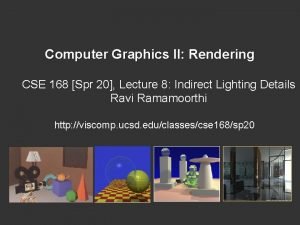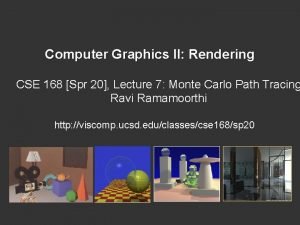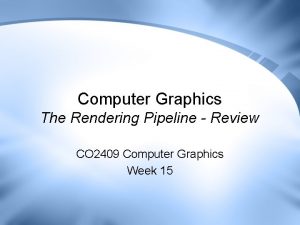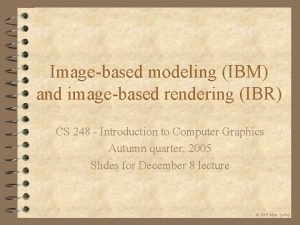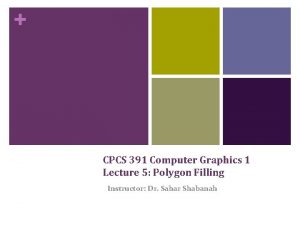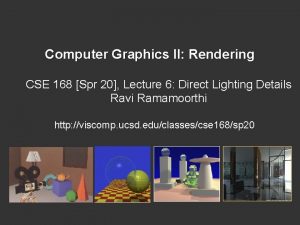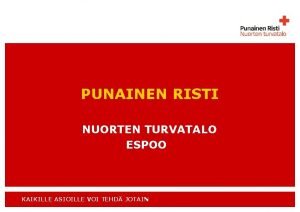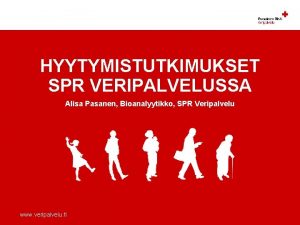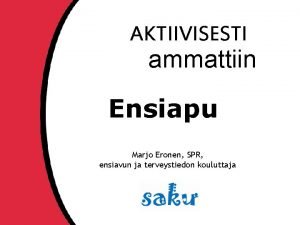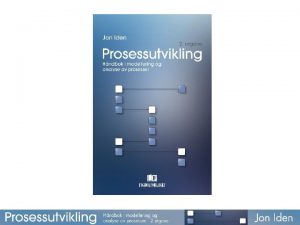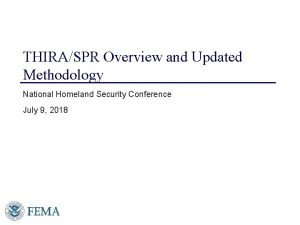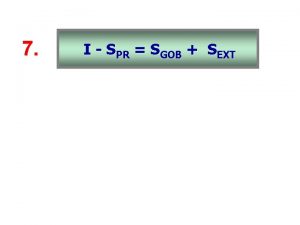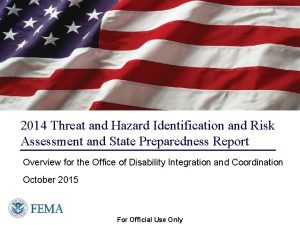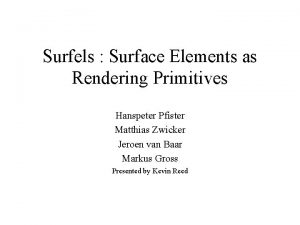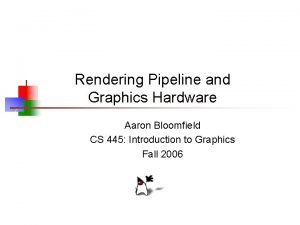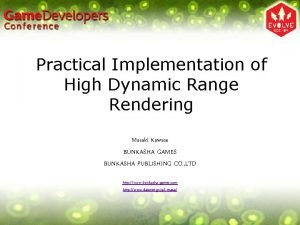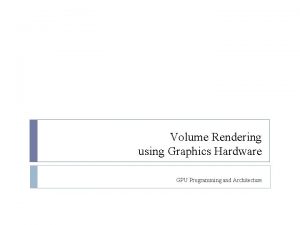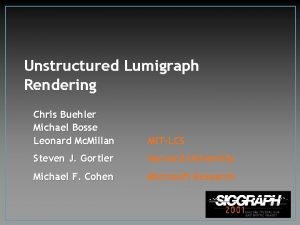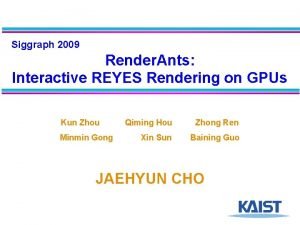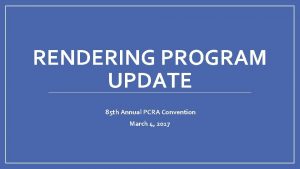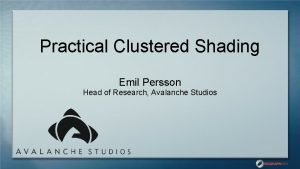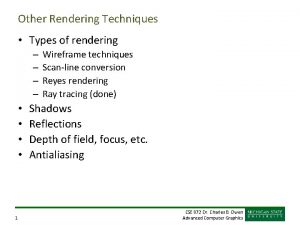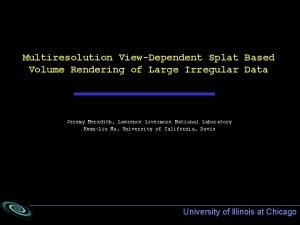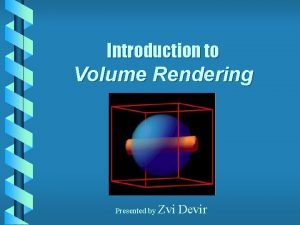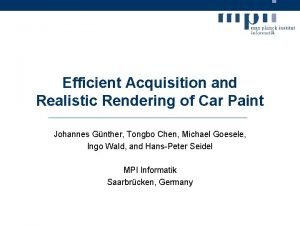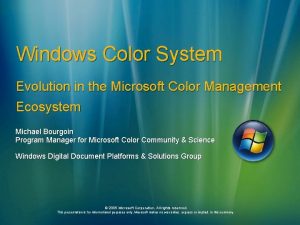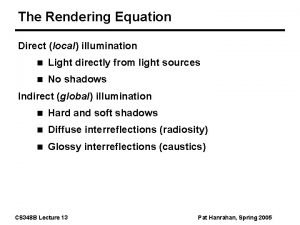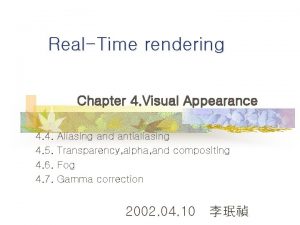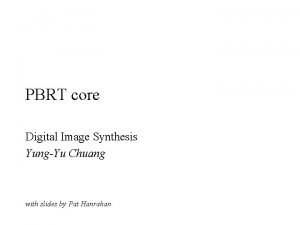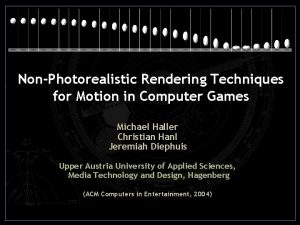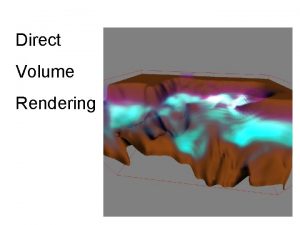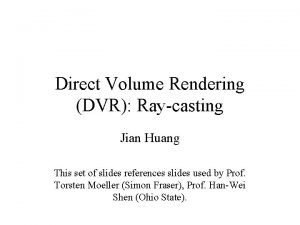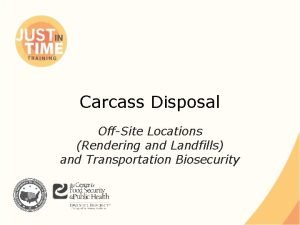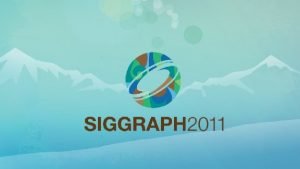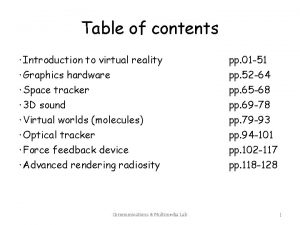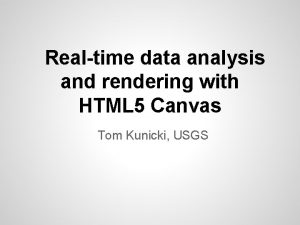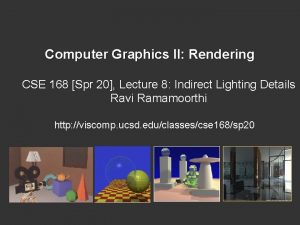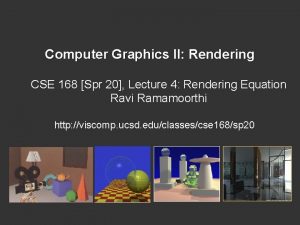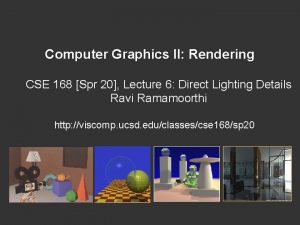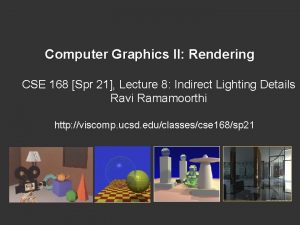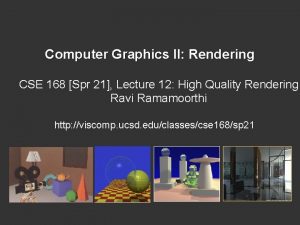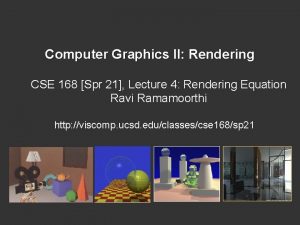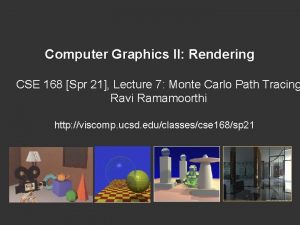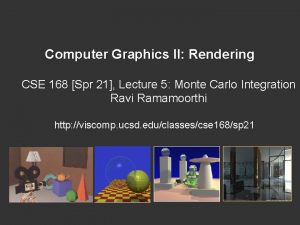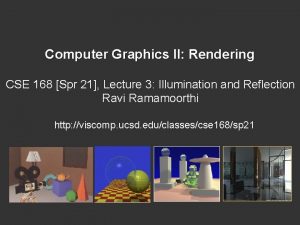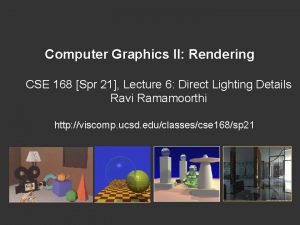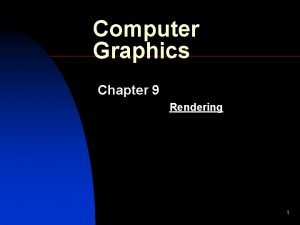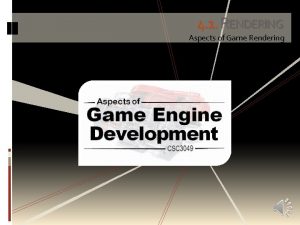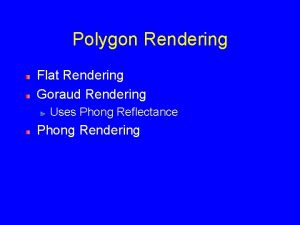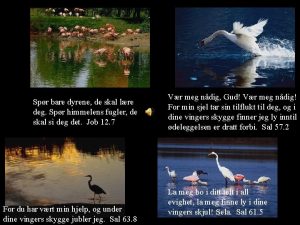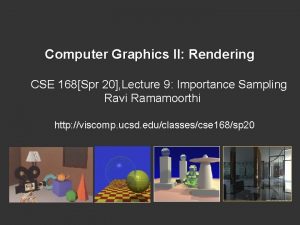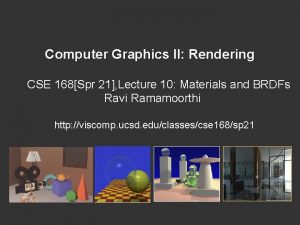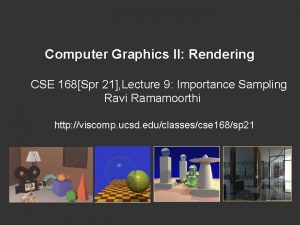Computer Graphics II Rendering CSE 168 Spr 20
![Computer Graphics II: Rendering CSE 168 [Spr 20], Lecture 12: High Quality Rendering Ravi Computer Graphics II: Rendering CSE 168 [Spr 20], Lecture 12: High Quality Rendering Ravi](https://slidetodoc.com/presentation_image_h2/75a8410428a83a287fb2ef44dac88e02/image-1.jpg)












![Light Ray Tracing Backwards Ray Tracing [Arvo 86] Light Ray Tracing Backwards Ray Tracing [Arvo 86]](https://slidetodoc.com/presentation_image_h2/75a8410428a83a287fb2ef44dac88e02/image-14.jpg)





























- Slides: 43
![Computer Graphics II Rendering CSE 168 Spr 20 Lecture 12 High Quality Rendering Ravi Computer Graphics II: Rendering CSE 168 [Spr 20], Lecture 12: High Quality Rendering Ravi](https://slidetodoc.com/presentation_image_h2/75a8410428a83a287fb2ef44dac88e02/image-1.jpg)
Computer Graphics II: Rendering CSE 168 [Spr 20], Lecture 12: High Quality Rendering Ravi Ramamoorthi http: //viscomp. ucsd. edu/classes/cse 168/sp 20

To Do § Homework 4 (importance sampling) due May 18 § These lectures cover more advanced topics § May be relevant for your final project § Or curiosity in terms of frontiers of modern rendering

Motivation § Rendering Equation since 86, Path Tracer in HW 3 § So, is Monte Carlo rendering solved? § Can it be made more efficient (90 s until today)? § Multiple Importance Sampling (Homework 4) § Irradiance Caching takes advantage of coherence § Correct sampling: Stratified, Multiple Importance, Bidirectional Path Tracing, Metropolis, VCM/UPS, … § Photon Mapping § Modern adaptive sampling, cut-based integration § Advanced topics (next time) § Denoising (next time)

Smoothness of Indirect Lighting Direct Indirect Direct + Indirect

Irradiance Caching § Empirically, (diffuse) interreflections low frequency § Therefore, should be able to sample sparsely § Irradiance caching samples irradiance at few points on surfaces, and then interpolates § Ward, Rubinstein, Clear. SIGGRAPH 88, A ray tracing solution for diffuse interreflection

Irradiance Calculation position rotation Derivation in Ward paper

Algorithm Outline § Find all samples with w(x) > q § if ( samples found ) § interpolate § else § compute new irradiance § N. B. Subsample the image first and then fill in

Irradiance Caching Example Final Image Sample Locations

Motivation § Rendering Equation since 86, Path Tracer in HW 3 § So, is Monte Carlo rendering solved? § Can it be made more efficient (90 s until today)? § Multiple Importance Sampling (Homework 4) § Irradiance Caching takes advantage of coherence § Correct sampling: Stratified, Multiple Importance, Bidirectional Path Tracing, Metropolis, VCM/UPS, … § Photon Mapping § Modern adaptive sampling, cut-based integration § Advanced topics (next time) § Denoising (next time) § High level: refs on slides, ask if need to track down

Better Sampling § Smarter ways to Monte Carlo sample § Long history: Stratified, Importance, Bi. Directional, Multiple Importance, Metropolis § Good reference is Veach thesis § We only briefly discuss a couple of strategies

D. Mitchell 95, Consequences of stratified sampling in graphics

Comparison of simple patterns Latin Hypercube Quasi Monte Carlo Ground Truth Uniform Random Stratified 16 samples for area light, 4 samples per pixel, total 64 samples If interested, see my paper “A Theory of Monte Carlo Visibility Sampling” Figures courtesy Tianyu Liu

Spectrally Optimal Sampling Mitchell 91
![Light Ray Tracing Backwards Ray Tracing Arvo 86 Light Ray Tracing Backwards Ray Tracing [Arvo 86]](https://slidetodoc.com/presentation_image_h2/75a8410428a83a287fb2ef44dac88e02/image-14.jpg)
Light Ray Tracing Backwards Ray Tracing [Arvo 86]

Path Tracing: From Lights § Step 1. Choose a light ray § Step 2. Find ray-surface intersection § Step 3. Reflect or transmit u = Uniform() if u < reflectance(x) Choose new direction d ~ BRDF(O|I) goto Step 2 § else if u < reflectance(x)+transmittance(x) Choose new direction d ~ BTDF(O|I) goto Step 2 § else // absorption=1–reflectance-transmittance terminate on surface; deposit energy

Bidirectional Path Tracing Path pyramid (k = l + e = total number of bounces)

Comparison

Motivation § Rendering Equation since 86, Path Tracer in HW 3 § So, is Monte Carlo rendering solved? § Can it be made more efficient (90 s until today)? § Multiple Importance Sampling (Homework 4) § Irradiance Caching takes advantage of coherence § Correct sampling: Stratified, Multiple Importance, Bidirectional Path Tracing, Metropolis, VCM/UPS, … § Photon Mapping § Modern adaptive sampling, cut-based integration § Advanced topics (next time) § Denoising (next time) § High level: refs on slides, ask if need to track down

Why Photon Map? § Some visual effects like caustics hard with standard path tracing from eye § May usually miss light source altogether § Instead, store “photons” from light in kd-tree § Look-up into this as needed § Combines tracing from light source, and eye § Similar to bidirectional path tracing, but compute photon map only once for all eye rays § Global Illumination using Photon Maps H. Jensen. Rendering Techniques (EGSR 1996), pp 21 -30. (Also book: Realistic Image Synthesis using Photon Mapping)

Caustics Path Tracing: 1000 paths/pixel Note noise in caustics Slides courtesy Henrik Wann Jensen

Caustics Photon Mapping: 10000 photons 50 photons in radiance estimate

Reflections Inside a Metal Ring 50000 photons 50 photons to estimate radiance

Caustics on Glossy Surfaces 340000 photons, 100 photons in radiance estimate

HDR Environment Illumination

Global Illumination

Direct Illumination

Specular Reflection

Caustics

Indirect Illumination

Cornell Box 200000 global photons, 50000 caustic photons

Box: Global Photons

Mies House: Swimming Pool

Motivation § Rendering Equation since 86, Path Tracer in HW 3 § So, is Monte Carlo rendering solved? § Can it be made more efficient (90 s until today)? § Multiple Importance Sampling (Homework 4) § Irradiance Caching takes advantage of coherence § Correct sampling: Stratified, Multiple Importance, Bidirectional Path Tracing, Metropolis, VCM/UPS, … § Photon Mapping § Modern adaptive sampling, cut-based integration § Advanced topics (next time) § Denoising (next time) § High level: refs on slides, ask if need to track down

Lightcuts § Efficient, accurate complex illumination Environment map lighting & indirect Time 111 s Textured area lights & indirect Time 98 s (640 x 480, Anti-aliased, Glossy materials) From Walter et al. SIGGRAPH 05

Complex Lighting § Simulate complex illumination using point lights § § Area lights HDR environment maps Sun & sky light Indirect illumination § Unifies illumination § Enables tradeoffs between components Area lights + Sun/sky + Indirect

SIGGRAPH 2005 Key Concepts LIGHTCUTS • Light Cluster • Light Tree – Binary tree of lights and clusters Clusters Individual Lights 36

SIGGRAPH 2005 Key Concepts LIGHTCUTS • Light Cluster • Light Tree • A Cut – A set of nodes that partitions the lights into clusters 37

SIGGRAPH 2005 Simple Example LIGHTCUTS Light Tree #1 #2 #3 #4 Representative Light 4 Clusters 1 1 4 2 3 4 Individual Lights 38

SIGGRAPH 2005 Three Example Cuts LIGHTCUTS Three Cuts #1 #2 #4 #1 #3 #4 4 4 2 #4 4 1 1 #1 3 4 1 4 2 3 4 39

SIGGRAPH 2005 Three Example Cuts LIGHTCUTS Three Cuts #1 #2 #4 #1 #3 #4 4 4 2 #4 4 1 1 #1 3 Good 4 1 4 2 3 Bad 1 4 2 3 4 Bad 40

SIGGRAPH 2005 Three Example Cuts LIGHTCUTS Three Cuts #1 #2 #4 #1 #3 #4 4 4 2 #4 4 1 1 #1 3 Bad 4 1 4 2 3 Good 1 4 2 3 4 Bad 41

SIGGRAPH 2005 Three Example Cuts LIGHTCUTS Three Cuts #1 #2 #4 #1 #3 #4 4 4 2 #4 4 1 1 #1 3 Good 4 1 4 2 3 Good 1 4 2 3 4 Good 42

SIGGRAPH 2005 LIGHTCUTS Tableau, 630 K polygons, 13 000 lights, (Env. Map+Indirect) Avg. shadow rays per eye ray 17 (0. 13%) 43
 168 spr
168 spr Cse 168
Cse 168 Rendering pipeline in computer graphics
Rendering pipeline in computer graphics Graphics rendering
Graphics rendering Graphics rendering
Graphics rendering Computer graphics
Computer graphics Computer graphics chapter 1 ppt
Computer graphics chapter 1 ppt 168spr
168spr Spr words
Spr words Spr kontti palkkatuki
Spr kontti palkkatuki Nuorten turvatalo tampere
Nuorten turvatalo tampere Spr veren hyytymistekijät
Spr veren hyytymistekijät Gtcs professional update
Gtcs professional update Kylmä koho kompressio spr
Kylmä koho kompressio spr Nicoya spr
Nicoya spr Prosessmodellering
Prosessmodellering Thira/spr
Thira/spr Introduction of evaluation
Introduction of evaluation I spr
I spr Thira spr
Thira spr Teknik bayangan adalah
Teknik bayangan adalah Blockinmax
Blockinmax Rendering pipeline
Rendering pipeline Masaki kawase
Masaki kawase Volume rendering tutorial
Volume rendering tutorial Unstructured lumigraph rendering
Unstructured lumigraph rendering Reyes rendering
Reyes rendering Photorealistic rendering carlsbad
Photorealistic rendering carlsbad Clustered shading
Clustered shading Shadow rendering techniques
Shadow rendering techniques Splat rendering
Splat rendering Introduction to volume rendering
Introduction to volume rendering Car paint rendering
Car paint rendering Windows color system
Windows color system Rendering equation
Rendering equation Rendering realtime compositing
Rendering realtime compositing Rendering equation
Rendering equation Game rendering techniques
Game rendering techniques Indirect volume rendering
Indirect volume rendering Direct volume rendering ray casting
Direct volume rendering ray casting Rendering of carcass
Rendering of carcass Advances in real-time rendering in games
Advances in real-time rendering in games David rosen sega
David rosen sega Rendering realtime compositing
Rendering realtime compositing
